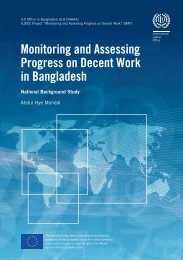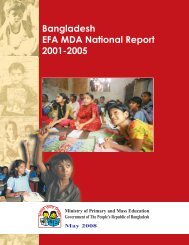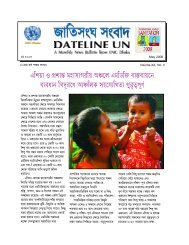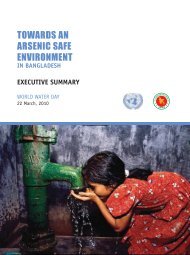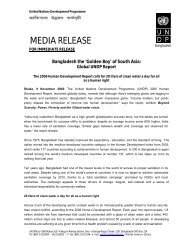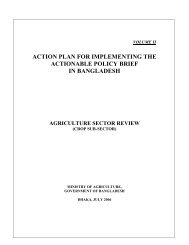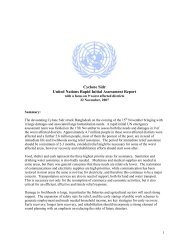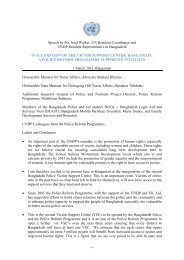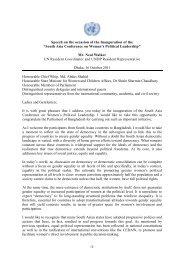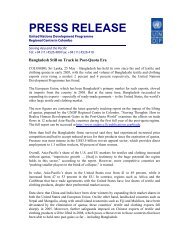MDG Report 2012 - United Nations in Bangladesh
MDG Report 2012 - United Nations in Bangladesh
MDG Report 2012 - United Nations in Bangladesh
- No tags were found...
Create successful ePaper yourself
Turn your PDF publications into a flip-book with our unique Google optimized e-Paper software.
3.1 Introduction<strong>Bangladesh</strong> has made good progress <strong>in</strong> <strong>in</strong>creas<strong>in</strong>g equitable access to education, reduc<strong>in</strong>gdropouts, improv<strong>in</strong>g completion of the cycle, and implement<strong>in</strong>g a number of qualityenhancement measures <strong>in</strong> primary education. It has already achieved gender parity <strong>in</strong> primaryand secondary enrolment. The government is <strong>in</strong> the process of implement<strong>in</strong>g acomprehensive National Education Policy (2010) to achieve its comprehensive objectives.The present challenges under <strong>MDG</strong> 2 <strong>in</strong>clude atta<strong>in</strong><strong>in</strong>g the targets of primary educationcompletion rate, adult literacy rate and quality of education.3.2 Progress of achievements <strong>in</strong> different targets and <strong>in</strong>dicatorsTarget 2.A: Ensure that, by 2015, children everywhere, boys and girls alike, will be able tocomplete a full course of primary school<strong>in</strong>gIndicator 2.1: Net enrolment ratio <strong>in</strong> primary educationThe net enrolment ratio (NER) refers to the number of pupils <strong>in</strong> the official school age group<strong>in</strong> a grade, cycle or level of education <strong>in</strong> a given school year, expressed as a percentage of thecorrespond<strong>in</strong>g population of the eligible official age group.In terms of br<strong>in</strong>g<strong>in</strong>g primary school age children to schools, the country is well on track ofthe <strong>MDG</strong> target. The net enrolment ratio <strong>in</strong> 2011 is 98.7 percent (Girls: 99.40%, Boys:97.2%). It was 60.5 percent <strong>in</strong> 1990 and 87.2 percent (90.1% for girls) <strong>in</strong> 2005. The fasterand relatively consistent growth <strong>in</strong> girls' enrolment vis-à-vis boys has been an importantdriver of the observed improvement <strong>in</strong> NER. Focused and substantive <strong>in</strong>itiatives undertakenby the government such as distribution of free textbooks among students up to the secondarylevel, provid<strong>in</strong>g scholarship to female students up to the higher secondary level, hold<strong>in</strong>gpublic exam<strong>in</strong>ations and announc<strong>in</strong>g results with<strong>in</strong> the stipulated time and creation of theEducation Assistance Trust Fund for the poor and meritorious students, food for education,stipends for primary school children, media outreach, and community or satellite schoolshave all helped <strong>in</strong> boost<strong>in</strong>g the NER. The government has been work<strong>in</strong>g to improve thequality of education alongside <strong>in</strong>creas<strong>in</strong>g literacy rate to build an illiteracy-free <strong>Bangladesh</strong>by 2014.Figure 3.1: Trends <strong>in</strong> Net Enrolment Ratio, 1990-2011Sources: BANBEIS and DPE39



